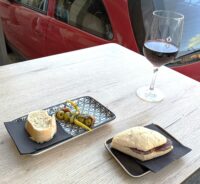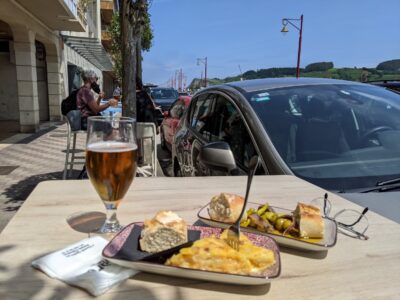August 4, 2021

My Camino Day 8/2 to 4 2021 – Zumaia
My Camino journal 2021 includes no notes from the two days spent in Zumaia. My camera, however, provides some good pictures and videos. Memory plays tricks, but those pictures seem to jog mine quite nicely.
The plan
My stay in Zumaia was included in my trip plan to deal with jetlag and the exhaustion of a long two days and one night of travel. The second day was “well, in case I need it” when the trip was being planned. In reality, there was no question of getting under way after only one night catching up. Perhaps that would have been fine for me to do at the age of 26. A half-century later, the second day was required, not optional.
My Camino Day 8/2
My arrival in Zumaia is described in My Camino Day 7/28 to 8/2 2021 – Washington to Madrid to Zumaia. It was a long trip both in kilometers traveled and hours doing so.
 The exhilaration I felt arriving at the Zumaia narrow gauge train station was very real. It combined victory on having returned, making good on my promise to myself, and relief that the long trip from home to where my Camino Journey would recommence was complete. I lifted my backpack onto my shoulders and began the kilometer or so, perhaps half a mile, walk to Mari Kalea and the Airbnb where I would spend two nights.
The exhilaration I felt arriving at the Zumaia narrow gauge train station was very real. It combined victory on having returned, making good on my promise to myself, and relief that the long trip from home to where my Camino Journey would recommence was complete. I lifted my backpack onto my shoulders and began the kilometer or so, perhaps half a mile, walk to Mari Kalea and the Airbnb where I would spend two nights.
 Finding the Airbnb was a little challenging as the numbering system in the small lane, that’s it to the left of the church in the picture on the right, confused me just a bit. This was not a major challenge, however, and I was soon settled in to Juan Luis Airbnb. The view from my window was wonderful.
Finding the Airbnb was a little challenging as the numbering system in the small lane, that’s it to the left of the church in the picture on the right, confused me just a bit. This was not a major challenge, however, and I was soon settled in to Juan Luis Airbnb. The view from my window was wonderful.
Tapas and pintxos
 Dinner that afternoon consisted of a couple of pintxos combined with a glass of vino tinto (pronounced “beeno teento” and meaning red wine). It is possible that there were two glasses of vino tinto.
Dinner that afternoon consisted of a couple of pintxos combined with a glass of vino tinto (pronounced “beeno teento” and meaning red wine). It is possible that there were two glasses of vino tinto.
The tapa is a Spanish social eating standard. Tapas are usually simple, perhaps a small plate of ham on toast or fried potatoes, and inexpensive, perhaps a couple Euros. While there are many that are common from place to place, there are also many that are not. My totally unqualified opinion is that there are probably as many different tapas as there are bars, which is to say that any attempt to itemize tapas is beyond the scope of this website.
The people of Spain often go out for a social evening in a small group, visit a bar, order a round of drinks and a few tapas to share (think one bite each), eat and drink, then go to another bar and repeat the process. They can do this for incredibly long periods of time.
The pintxo is a slightly larger, fancier tapa. It costs a bit more, say three or four Euros. While it is sometimes seen as local to the Basque Country of Northern Spain, the pintxo is now common in Madrid, and probably most of the rest of Spain, as well.
Pintxos (or tapas) and vino have been typical of my meals in Spain. I have many pictures of pintxos, tapas, beer, and wine from 2021 as the food was inevitably very welcome after a long day, delicious, varied, and satisfying.
Food along the Camino
Many pilgrims choose to shop in a grocery and cook their meal either in an albergue (or hostel) kitchen to save a bit of money. This works very well. Pilgrims maintain their special diets, their food preferences are respected, and the social experiences of sharing a kitchen and a table are wonderful. The limitation on doing this is that it has its limits. The kitchens are often very limited in albergues and hostels.
Camping and cooking using a camp stove is common. This is a low cost approach that adds significantly to the load in one’s backpack. It also provides very limited cooking capability and little convenience.
Thus, I use the albergue or hostel kitchen when it seems simple and easy and buy meals in bars when it does not. My experience doing this, which emphasizes pintxos and tapas, has been very positive. The food is excellent and generally reasonably priced. Importantly, it is a very easy solution that comes with my preference for something to drink, usually beer or wine, at the end of a strenuous day.
My Camino Day 8/3
Zumaia is a small, but significant, port located on Rio Urola a half kilometer or so, about a quarter mile, upstream of the Bay of Biscay. The port is well protected from the storms that the Bay of Biscay can produce. At this point in its journey to the sea, the Urola is no longer truly a river, but rather a tidal estuary.
 Zumaia is in el pais Vasco (the Basque Country) of Northern Spain. It is a semi-autonomous political district with its own language, Euskara, which is commonly spoken as well as Spanish, and a history of wanting to separate itself from Spain.
Zumaia is in el pais Vasco (the Basque Country) of Northern Spain. It is a semi-autonomous political district with its own language, Euskara, which is commonly spoken as well as Spanish, and a history of wanting to separate itself from Spain.
 There are a lot of people who assert that the best food in the world is in Spain and the best food in Spain is in the Basque Country. Whether that is true or not, it sounds true to me based on my limited experience and even more limited knowledge of food. An example: the Spanish tortilla. For those who have not enjoyed the Spanish tortilla, it is potatoes and onions fried in olive oil, then mixed with eggs and fried again to produce a dish about the size and shape of a pie. It is a tapa served in slices akin to pie slices, usually with a piece of bread; one makes a very nice breakfast. That is a Spanish tortilla in the foreground on the left.
There are a lot of people who assert that the best food in the world is in Spain and the best food in Spain is in the Basque Country. Whether that is true or not, it sounds true to me based on my limited experience and even more limited knowledge of food. An example: the Spanish tortilla. For those who have not enjoyed the Spanish tortilla, it is potatoes and onions fried in olive oil, then mixed with eggs and fried again to produce a dish about the size and shape of a pie. It is a tapa served in slices akin to pie slices, usually with a piece of bread; one makes a very nice breakfast. That is a Spanish tortilla in the foreground on the left.
The plate in the background on the left are two pintxos that consist of peppers, olives, and boquerones (fresh anchovies cured in vinegar and olive oil and nothing like the ones from a can in the States) on a skewer. They are delicious. Some bread completes the dish.
 One of the local sporting events, something that I saw for the first time in Pasai Donibane back in 2018, is whaleboat racing. The Bay of Biscay provided real opportunities for whalers “back in the day” and whaling was a major factor in the area’s economy for many years. Today, however, whaleboat racing is a sport rather than an important, even critical, skill in an industry that has almost disappeared. It is very common to see the local whaleboat racing team practicing or, as was the case in Pasai Donibane, competing.
One of the local sporting events, something that I saw for the first time in Pasai Donibane back in 2018, is whaleboat racing. The Bay of Biscay provided real opportunities for whalers “back in the day” and whaling was a major factor in the area’s economy for many years. Today, however, whaleboat racing is a sport rather than an important, even critical, skill in an industry that has almost disappeared. It is very common to see the local whaleboat racing team practicing or, as was the case in Pasai Donibane, competing.
My Camino Day 8/4
Memory plays tricks, but mine says that my time in Zumaia on the fourth was very limited. There was coffee, or must have been, and a quick breakfast. But then it was time for me to head out on the next piece of my Camino Journey, a hike to Deba … and beyond.
